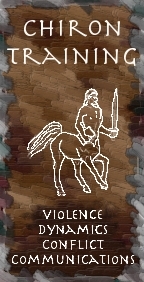|
|
||||||||
|
In This Hub: An Intro to Self-Defense Anger and Self-Defense Assertive or Aggressive? Are Martial Arts Self Defense? Best Self-Defense Weapon Boundaries Crime ISN'T a Fight Economy & Stress Violence Finding Good SD Training Five Stages of Crime How NOT To Get Shot How To Get Attacked Kinds of Violence Legalities of SD Mental Preparation Nature of Violence Personal Safety Pyramid* Physical Training* Pride, Self-Defense & Fighting Problem Neighbors Repercussions of Violence SD and You SD ISN'T Cut and Dried Self-Esteem and SD Violence Geeks Blog What's With the *? NNSD Home Page
Marc MacYoung?
Fiction
Non-Fiction
|
It's easier to
instill confidence Why So Much SD Training Is Off The Rails
On this page: Let me start by saying most self-defense training is as screwed up as a soup sandwich. There's good training out there, but there's way more bad. You need to know that to be an informed consumer. Most so-called 'self-defense' training
falls down in one or more of these categories: Something else you should know is the market is a squirrelly mix of: What he's showing are solid and necessary fundamentals (but kind of boring). She has a good tidbit. What the other person just said is a gem. What someone else said is true, but it's more an advanced concept you'll need other stuff before you can use it. (And if you try using it now, it'll go wrong.) Oh and what that other guy just said? It sounds good, but it'll get you killed. That other clown? If you do that, you'll end up in the prison showers. Unfortunately these problems are systemic because both the instructors and the customers often have ...well, what could be called a dysfunctional relationship. But even if the relationship is functional, that still doesn't mean the information is good. Or to put it another way, that the information is related to the actual issues involved in self-defense. But everyone is telling themselves what they're doing is 'self defense. Just ask 'em, they'll tell you. I'm going to line out some extremes so you can see the middle. I do this, so if you're a middle kinda person, you can both find training for your needs and keep from being lead out toward left field. (Where many will want to take you.) If you're not in the middle, I'm going to give you things to consider so you can at least start to head back in the right direction. That being towards finding the middle again. You know, a direction that will keep you alive, uninjured, not dead, out of prison or successfully sued for everything you own. Welcome to the complex reality of self-defense vs.
the simplistic fantasies of most self-defense training.
The problem is there are real world issues about defending yourself.
Problems that most training doesn't prepare
you for.
Scaled problems require scaled responses Some years ago I watched a commercial martial arts 'master' teach a neck break from behind, on a downed and helpless opponent. It was a sentry removal technique he'd picked up somewhere and he casually taught it to his black belts. He saw my look of horror and quickly added, "But this is for self-defense only." No. No, it's not! On a specific type of military mission or Black Ops that neck break is appropriate. For civilians, it's murder. I knew it. He didn't, neither did the students he just taught. ( 1) I tell you that story to highlight the next point. The real problem is that 'good information' for one situation can -- literally -- be a disaster in other circumstance. To this end: It's not enough
just to know a technique. I use the term "appropriate for the circumstances" quite a bit when talking about self-defense. This isn't just if it's legally justifiable for the circumstances, but also if (given the circumstances) the move will work or not. On the Self-Defense hub I used an
analogy of a public swimming pool. A
pool that has a shallow end, a
middle and a deep end. I'm going to
expand on that general idea by with
the following Easy right? Now consider this If where it works, where it doesn't, when to use it, when not to isn't taught along with every physical technique then you're floating into 'bad training' territory. Why do I say that? Because when it comes to using your
training to defend yourself you'll face one of two problems: Welcome to the complexities of self-defense in a civilian context. Oh yeah, and while we're at it, until you have what I refer to as 'faith' in you training and experience of not panicking in violent circumstances part of your brain will be screaming at you that it's all C level danger you're facing, so go ahead and use your nuclear responses. Uhhhh... no. In fact, not only no, but hell no. That's the bad news. Now the good news, these levels are both knowable and easier to operate in once you start thinking about self-defense in terms of levels and appropriate responses.
Fantasy vs. Knowing The Real Problem People's fears come from their imagination. The problem with that is it's hard to tell the difference between what you know and what you think. That's important because "thoughts precede emotions." ( 2) That's to say how and what you think has a lot to do with your emotions -- especially fear and anger. Two very powerful motivators. Simply stated, many people who go looking for self-defense training are more afraid of how they believe crime and violence happens than how these events occur. In fact, most of what people think-they-know about these subjects is either flat out fantasy or marketing. A businessman by the name of John Wanamaker famously quipped, "Half the money I spend on advertising is wasted; the trouble is I don't know which half." We can tweak that to say "Half of what you think you know about self-defense is fantasy..." Just so you know, it's not your fault. So where do they get these fantasies? Well, mostly from Hollywood. Think about a subject you know very well. It doesn't really matter what it is. Just that you really do know something about the subject. When you see it portrayed on the screen, how badly does Hollywood mess it up? An example, something you know takes days, weeks if not months, is done in under a minute --or five-- to keep the story moving along. (You see this all the time with forensics in cop shows. In real life, a 'rush' usually means a week.) What they're seeing on the screen is usually the closest most people ever come to crime and violence. You can say that you know Hollywood isn't real, but what parts of what's in your subconscious about crime and violence is real and what's a Hollywood misconception? It's a damned important question. In the movies the bad guys are always obvious. But do you know how many muggings start with the words, "Excuse me"? The answer is, "A lot." The other sources of bad information is... well a jambalaya mix of issues. It mostly has to do with people stating -- with confidence --what's self-defense. Believe me that can head out into some barking moonbat territories. (As bad if not worse than that neck break.) But before things go into la-la land, information has traveled through the counties of 'sometimes,' 'not exactly,' 'it's a little more complicated than that,' 'no,' 'not even,' and 'flat out wrong.' Then you enter "Whisky Tango Foxtrot" land. That's why you need to have at least a basic understanding of
how crime and violence happens before you walk through
a school's door. Not fantasy, but solid
verified knowledge. This allows you to put
the school's information in context (and
also see where it doesn't fit). Later we'll
talk about the filters to run information
through to help you cut through nonsense. "What We Teach Is Self-Defense." (No.
No, it's not) This combo can leave you vulnerable; not just to deliberate manipulation, but sincere misinformation. Now let me point something out, both the martial arts and the 'self-defense field' are both not regulated and self-certifying. That's to say there's no oversight other than business standards. (Most issues with martial arts schools are contract disputes.) That means no quality control except what the instructors themselves insist on. Also most the certifications you see hanging on the wall aren't from accredited sources. That certificate is not a law degree. It's not a university, a formally recognized organization for maintaining professional standards in the field (e.g. the American Medical Association), or a government agency handing out that certification. Yes the NRA hands out teaching certifications, but that means the instructor has met the NRA's standards. An instructor can lose certification from an informal organization and there's nothing to stop him from still teaching. This means the whole business is a 'buyer beware.' In the Martial Arts Culture sub-hub I talk extensively about the business influences on training -- especially what it takes to stay in business. That has a lot to do with what I'm about to explain. See, back in what my kids call 'the pterodactyl days' of my youth, we used to fight at school. Sure we knew fighting was 'wrong' and we'd get in trouble. But sometimes you just had to and you'd both end up sitting in the vice- principal's office. In a wider social sense, it was understood that fights happened. Sure they were largely considered lower class, but there were issues that were worth fighting for no matter who you were. I tell you that because, when you went into the martial arts, fighting is what you were there to learn. They made no bones about it. You were especially learning how to fight if you wanted to go into competition. Which was full contact back then. Times change. Now, without fundamentally changing the techniques they're teaching, martial arts schools claim to be teaching self-defense. Because you know...fighting is bad and you shouldn't do it. That's why what they teach 'self-defense' instead. Okay, so what's the big deal? The goals of fighting are completely different than self-defense. As such the strategies, tactics and decisions are different. Radically different. Typically fighting is to win. You participate and stay engaged until that goal is achieved. Oh, and while we're on the subject, did you know self-defense is legal, but fighting is illegal? That's how different it is. Also while fighting hurts, it's seldom injurious -- as it's supposed to be. Grossly over-simplifying things, fighting can be understood as being about social issues. Issues ranging from dominating and imposing you will over someone else, to rule enforcement, putting a stop to unacceptable behavior, establishing status to just plain old fun. Self-defense is to end the danger to you--including engaging only long enough
to escape. Or just running fiercely. If appropriate,
self-defense can include serious injury and even
killing. What doesn't change is it's about stopping the same from
happening to you. Remember this? When you think about it from that perspective, a lot of fighting techniques don't make sense for self-defense -- especially women's self-defense. Why do you want to use fighting techniques -- especially sports fighting moves? Not only are those likely to extend the conflict, increase your chances of getting hurt, cross the line into illegal violence, but they have a horrible failure rate outside the ring. (Sports fighting has weight and experience divisions, self-defense doesn't.) In case you're not following I'm talking about using an A level response in a C level situation. Which if you'll remember I dubbed a disaster. That's a big issue with teaching fighting arts as self-defense. But there's another problem. I said 'without really changing.' That technically isn't true. Remember the fights in school I mentioned? In those fights we tried to hit each other as hard as we could. Same went for full contact tournaments. I tell you that because while they are still teaching fighting forms and sparring, a lot of MA schools have watered down what they're teaching because students don't like getting hurt and for insurance purposes. Few schools do full contact any more. (Mixed Martial Arts and muay Thai tournaments are pretty much the only ones left.) If you think about it, light contact is rather disturbing trend. This especially when you think of what being taught as martial arts often lacks the necessary 'mechanics' to handle the incoming force of an actual attack. This is one of the reasons martial artist so often fall apart when someone comes at them full force (another issue is adrenaline). Their defenses literally collapse. Do the moves --that work so well against light- contact -- also work when someone is trying to hit you as hard as he can? How do you know? ( 3) Seriously how do you know your self-defense moves will work against a committed attack? Your life might depend on the answer. There are all kinds of safety protocols you can do (like the attacker telling you what is coming and safety equipment in case of failure), but have you force tested the moves? Moves that you very well could be staking your life on them working. The other extreme is selling full contact/sports fighting as 'self-defense.' I tell people to take a mixed martial arts match and imagine it in a bar or parking lot. What would you call that? I'd call it a fight. And so should you. It doesn't matter if you call it reality based self-defense or some variant of MMA, they're teaching how to win a fight. I tell you this because something else from those pterodactyl days. That was the cops telling two guys who got into to just go home or they'd both be arrested. Now days we have -- if not by law, in practice -- mandatory arrest. Someone HAS to go to jail. 99 times out of a 100, that's going to be the 'winner.' Three guesses what successfully defending yourself is going to look like to the cops? And the first two don't count. So knowing that, let me ask you, "How much time does you self-defense instructor spend working with you about explaining to the cops why it was self-defense and not you fighting?" Or is all the time spent on physical technique? There's another thing lacking in this approach, a whole lot of self-defense programs focus on teaching smaller, weaker people to go berserk against an attacker. Basically the response is a blitz; to completely unload on someone and overwhelm him with the ferocity of your... wait for it... repeated sport attacks. The idea is you literally 'throw him a beating' before he can rally. I'm going to be generous and say that this strategy has about a 50/50 chance -- when it comes as a surprise. Thing is I've seen a lot of blitzes in my life. And I'll tell you right now, I've seen them work. I've also seen them fail. Most of the times I've seen them work is when it is a bigger stronger person blitzing a smaller, weaker or same sized opponent. Throw into that mix inexperienced or lesser experienced opponents. So yes, blitzes can and do work. But like I said I've also seen them fail. Fail against experienced opponents, larger opponents and especially against pissed off and ready to throw down opponents. If the person isn't surprised, or if your commitment isn't enough to overwhelm him, he IS going to rally. Or worse, he's mad enough to come right back at you with the same level of ferocity and violence. That turns it into a competition over who's going to collapse first. So remember that 50/50 success rate? It's dropping fast This also ignores the very real possibility that the first hard-and-fast attack wasn't yours. Quit often, you're not going to get that first hard shot off, he is. THAT'S why having defenses that can withstand a full force attack is so crucial. If you're already laying on the floor stunned you're not going to get a chance to blitz him. (On the Home Invasion page I talk about the common trick serial rapists pull on women -- after hitting them as hard as a man hits another man.) On the other hand, if your attacker is underestimating you, there's a good chance he won't go for a blitz, so you have a better chance of rallying after you block. That is a time where a countering blitz works well. But you have to keep from getting knocked out first. Oh and did I mention that on our scale a blitz would be a B level response to B level circumstances? Doing a sports blitz against someone trying to kill you is a good way to help him achieve his goal. Now you really want to get scared? Care to guess how many people want to skip all this fussing and fighting and jump straight ahead onto lethal force? You know, training in knife or gun 'self-defense.' 'Cause you know if they have to defend themselves, it will be automatically be life and death. That's if they want any training at all. There are a lot of folks who get a gun for self-defense and don't even bother with training because they know what 'self-defense' is. And many of those who are carrying concealed haven't taken anything past the required four hours mandated to get their permit. (What they don't realize is the paperwork they signed when they got their permit was them accepting legal liability for all the things they don't know about using their gun.) Along those lines, this issue of over selling what they teach as self-defense also exists in the shooting world -- especially in the higher levels of training. Where, for example, entire weekends can be dedicated to tacti-kool issues like clearing your home under low light conditions. Wait a minute, if we're talking about self-defense, why are you leaving your room and hunting down an intruder? Once again, the imaginary issues are outweighing the realities of home invasion and coming across a burglar. You really don't want to go hunting for a prowler by yourself -- especially if you live in a state without castle doctrine laws. The points I am talking about should be a bucket of ice water on a lot of what is sold as self-defense. But for reasons you're about to see it's not. Those reasons are why instructors aren't going to stop them from over-selling whatever they teach as self-defense. In fact, selling anything else they can tack on as 'self-defense.' There's money to be made off fears. So really how are you going to know if what you'd be paying for from that source even applies to the issues involved in self-defense? This especially about the legal consequences of if it works? That's where most people get into trouble. That blitz we just talked about? If there's video convincing the jury it was self-defense is going to be a hard sell -- even if you're a woman. The problem isn't the first two hits... it's the next ten. I repeatedly talk about self-defense being a legal term. Another way to understand it is it's circumstantial. That's to say what is self-defense in one set of circumstances is excessive force under others. Are you being taught when to use these moves and when not to? How much time is spent teaching you what's involved in scaling force for different situations? How much time is spent developing the ability to do while adrenalized? I ask because a drunk taking a swing at you requires a different level of force than someone coming in to kill you with a knife... but both are self-defense. Or does your instructor tell you to go hog wild because it's all 'self-defense.' If that's what you're being told, your instructor is more of a danger to you than the guy you're facing. Don't believe me? Try running the 'whatever I do is self-defense' idea past a cop or a lawyer and see the reaction you get. Do it before you actually use your training and find out about by getting arrested and needing a lawyer. Self-defense is very much about
understanding and staying within appropriate
use of force parameters. Or to put it in a
more tongue in cheek way, self-defense is
very much a Goldilocks and the 3 Bears
issue. This is too much. This is too little. This is just right.
Self-Defense Isn't Therapy. Nor Is It About Feelz But, there's a big difference between training 'giving' you something and it being a part of you developing important life skills and attributes. What I'm saying is while self-defense training can be part of a solution, it is not -- nor should you try to use it as -- a replacement for therapy or a self-esteem builder. But a lot of people do and a lot of instructors pander to that because that's where the money is. It's also where a lot of nonsense starts creeping in to what is being called self-defense. To help you understand why this can be a problem I'm going to use an old therapy concept by saying this: Self-defense is the ultimate wheelbarrow test. Okay, first off. What's a 'wheelbarrow test?' Simple. "Can you put it in a wheelbarrow?" If something has a physical existence you can. If something doesn't have a physical existence, you can't. While whatever-that-issue-is may be important, it isn't as 'real' as something physical. This is something we tend to forget. When we do, we start prioritizing other things. Things that don't have a physical existence. Often at the expense of those things that do. This is especially common in environments where physical safety is normally assumed (e.g., most life in first world countries 4). So why do I say SD is a wheelbarrow test? You can crawl in and physically sit in a wheelbarrow. You can't put your emotions in a wheelbarrow. You can't put your pride into a wheelbarrow. You can't put your self-esteem or confidence into a wheelbarrow. You certainly can't put you past trauma in a wheelbarrow. Self-defense is about protecting your body. We can expand it to say using appropriate strategies and force to achieve that protection, but that's where what is -- isn't -- self-defense needs to start and stop. Unfortunately, that's not where the money is. The money is in self-help, tacti-kool, toys/gizmos, social networking and pandering to fantasies. And that's what most training is going to sell you. Knowing that can help you from being led off into la-la land about the subject. Sometimes it's pop-psychology other times it's dangerous misconceptions (like 'tap into your anger') or that self-defense is about protecting your feelings and/or rights. Why would that be a problem? Well, we can do an everyday wheelbarrow test. When it comes to prioritizing, look around and see how many people put their feelings over their body. (Before you answer are you including addiction, alcoholism, obesity, self-harming and suicide? I am.) Here's the problem with that, those other issues are often -- if not overwhelmingly -- what puts us into physical danger. By prioritizing protecting the physical we avoid many of the common pitfalls and unintended consequences that come from prioritizing other issues For example: Contrary to what you might think it's not low self-esteem driving the plague of violence, in fact, there's good evidence that it's the exact opposite. It's often having unrealistically high self-esteem and expectations of how you should be treated that leads to anger and violence. (Getting over "I'm special" is a big issue in anger management.) It doesn't take a Ph.d in psychology to see how encouraging violence over one's feelings can be problematic. Now by now I'm going to have a lot of "Our training builds self-confidence," agenda peddlers and the Never Again Brigade spitting nails with what I'm saying. Tough. If people want ideas about how to overcome trauma and dysfunctional pasts then I suggest taking a look at the side bars. Those are books written by psychologists and recovery specialists. If you're an instructor teaching the traumatized then I strongly suggest you do some reading too. I said it before and I'll say it again: Self-defense is about protecting your body. We can expand it to say using appropriate strategies and force to achieve that protection, but that's where what is -- isn't -- self-defense needs to start and stop. Now are there attendant issues involved? No question. Are there emotional and mental 'roadblocks'? Oh yeah. Is there massive social conditioning against violence? You betcha. Is there hesitation to use force and self-doubt? Bingo. Are there physical limitations? Absolutely. And most importantly, is there fear that it won't work? Ooooohhhhh yeaaaaah. All of these and more are issues surrounding the subject of self-defense. Having said that, they are not, self-defense. Are they important? Of course, especially if you have problems with them. If you don't they're not really germane to your needs. So if you walk into a school or training and that's what they're on about, what they are teaching is not self-defense. There's another agenda at play. Now can you learn something useful there. Well maybe. But don't drink the Kool-Aid -- especially if it's looking more like a clinic for victims. Can self-defense training help you fight your mental gremlins -- especially about past traumas? That depends. Good training can help you with solid resources you can use to shut down them whispering their poison. Remember, a lot of fear is from imagination not actual knowledge. You may be uber-paranoid about being attacked after an incident, but do you consciously and rationally know what is required to successfully attack someone? (It's called the Five Stages of Violent Crime.) Here's a hint, if you don't see them, you're not in immediate danger -- regardless of what the mind gremlins are telling you. On the other hand, this kind of training can also empower dysfunction, promote aggression, overconfidence and further inhibit the development of effective social skills. You know...the kinds of things that generally keep you from having to 'defend' yourself. So how do you tell the difference? Generally you can tell when you contact them and ask: What's the goal of this training? Listen closely to what they
emphasize in their sales pitch.
Five filters to assess SD training When it comes to self-defense techniques the filters
are slightly different. They are: So why are the filters different? Simple. The main difference between martial arts training and self-defense training is with the latter you have to plan on using it. 1) Does the move have the required mechanics to work? Simply stated it's not the 'technique' that does the work. Work is the development and delivery of force (or dealing with incoming force). A technique is a way to manifest the physics. When the component parts are there you get good mechanics. When they are you get... well, arm waving. This is big subject that we cover more extensively in the MA Training and MA/SD/DT Training pages. But let me give you an example of the diagnostics I'm talking about. In the auto repair field there's an old saying. "If a car isn't running it's either not getting fuel or fire." Knowing that you can run checks on those systems until you find the problem. In terms of defensive action there are two fundamental components. Moving and shielding. In simple terms get out of the way of an attack and put something up to keep it from following you. If you get hit, then you're not doing one (or both) of these. ( 5) Knowing these standards you can look at any 'block' or defensive action to handle an incoming attack and see if it would work or not. 2) Does it work against a larger/stronger/non-cooperative person? 3) How specialized/over-generalized is it? There is, however, certain training tailored to specific groups. This isn't just professional, I'm also talking identity groups. Let me start by acknowledging there are certain issues that are unique to a particular group. These issues do require an adjustment of the information being taught. For example fingernails and firearms training. (Hint to firearms instructors, instead of telling women to cut their nails, adjust the grip you teach them to accommodate long nails.) Breasts and ever changing clothes type are other real issues when it comes to teaching women self-defense. Training has to be adjusted and work arounds found. Something else that needs be acknowledged is often people -- when learning about an uncomfortable subject -- are more comfortable surrounded by 'their own.' Again going to the firearms world, many women are more comfortable initially learning from female instructors in an all women's class. Having said that, the simple fact is that the majority of the information about self-defense is the same -- regardless of who is in the class or who is teaching it. If it's not, there's a problem. Let me give you both an example and something to consider. Is rape a subject that is specific to women or is it a subset of violence? Simple question, profound implications and influence on training with either answer. If rape is a subject unique unto women, then one can argue -- and many do -- that no man can 'understand' the issue. Therefore no man is qualified to talk about the subject (despite the fact that at least half the people involved in heterosexual rape are men). The circumstances are unique and none of the issues involved in violence (in general) apply to the subject of rape. This approach also allows for the subject to be politicized, campaigns to 'raise awareness,' education, lobbying and calls for social change. It's not hyperbole to say this can go to the national level. Look up VAWA (Violence Against Women Act). It is not unrealistic to say with this approach, somewhere along the line the individual will be lost. This includes much of the information being provided does little to keep women safe from rape. In fact, if it gets too idealistic, it can increase a woman's chance of being sexually assaulted or harmed in other ways. However, if we look at rape as a subset of violence, then we can begin to apply many of the causes of other types of violence to this subject. Causes with known and proven counters. In doing so, we give women the ability to significantly decrease their chances of being sexually assaulted. Are there still issues specific to certain type of rapists? Yes serial rapists and sexual predators do exist. But not all rapes involve them. Drunken anger is a far more common motive -- same with other kinds of violence. But are you going to be taught that in an agenda driven program? Probably not. If your goal is not to be raped, what type of training would you prefer? Again the trick is to run the training through the filter of what you
know The other extreme is over-generalized. Does this training purport to train you for all different kind of situations? For example, will you -- when you sign up at the martial art school -- be taught everything from bare hands, traditional weapons, gun and knife disarms and how to handle every possible scenario? All under the name of 'self-defense.' Look out for what I call 'one-stop-shopping.' In super-schools most of the topics relevant to self-defense are given a hand-wave of "Oh we teach that too" before turning back to teaching you physical techniques with not context. 4) What is the context for its use? Like the neck breaking ninja, I was appalled. In the state I live in that's called, "felony menacing." Other states call it "brandishing" and it's a felony too. It's one of those things you agreed not to do when you signed all that paperwork for your concealed carry permit. Was there an immediate threat of death or grievous bodily injury to her? Doubtful. Was she scared an only had one level of force at her disposal? That we can be pretty certain. Did she commit a felony because she lacked other options? Yep. Something I tell people is they have to understand the need for scaling force. You don't use the same level of force on Drunken Uncle Albert at a family reunion as you do against someone who's coming in with a knife to kill you. The same goes the other way around. Are they teaching the context for using the technique or are they just throwing it in the general 'self-defense basket?' 5) What are the legal restrictions on its use? Except for one thing, a knife is a lethal force instrument. That means use on another human being -- and I mean any use -- falls under the restrictions of lethal force. Which is the most narrow and aggressively prosecuted form of violence. What that instructor was telling people to do could be charged as attempted murder. Or the more common aggravated battery. And flat out, for cutting someone who was just reaching for you, that would be an easy conviction. Yet there was the instructor talking about it being 'you defending yourself.' I'm going to suggest that you take a trip over to the
Legal
Hub to help you develop this filter about when... and when not to ...
use the move the instructor is telling you is okay because it's
self-defense.
So Am I Saying You Should Just Lay Down And Die? What I am saying is that when it comes to self-defense training, you have to drop the attitude of "If it ever happens, I'd..." and take the more pragmatic, "When this happens these are the factors I must deal with" -- especially if you don't want to get hurt or end up in prison. I'm not saying this approach isn't a lot of skull sweat and work. But violence is real and so too are the consequences.You really need to sit down and do an assessment for the kind of issues you are most likely to encounter given your lifestyle. When you do this, most of what is sold as self-defense training will reveal itself as unnecessary for your needs. Simply stated if you're not in certain professions, live in certain areas or living a high risk lifestyle, you're pretty safe. Realistically you don't have to be paranoid or devote your life to training to handle being jumped by 27 ninja. But you do need to do a risk analysis of your life and cover those bases. Remember: Train for what happens most and you'll be able to handle most of what happens. And that includes knowing when it's time to turn and walk away so nothing happens.
1) When we spoke later he admitted he thought my objection was him teaching a killing technique. (Kind of a stupid assumption given my skills with knives.) My objection was him first teaching students a murder technique without that label and then mislabeling it self-defense. Gawds help any of his students who -- in an adrenalized state -- do that move thinking it's 'self-defense.' Return to Text 2) This is an actual psychological concept. Unfortunately to the layman, it's a bit of a 'which came first, the chicken or the egg?' It makes more sense if you go beyond any specific thought you have and work your way down to a more generalized 'how you think.' If you consider the generalized 'how' as a foundation of a building, then 'thoughts precede emotion' makes more sense. Like the foundation of a house shapes and supports the building, the 'how you think' foundation' shapes your emotions and dictates your emotions. For example, if you think getting angry and loud is an appropriate response, that's what you're going to do when something triggers you. It appears someone will react 'without' thinking, but actually the thinking has been done and decided long before. Now it's just emotional reaction. Return to Text 3) Don't deliberately try to misinterpret this as a call to abuse students. Going slowly and with controlled force is a very, very, VERY important aspect of learning the mechanics (what has to be there for it to work) of moves, ingraining those mechanics (so they're there even under stress) and learning why they HAVE to be there (having a block collapse can hurt more than just not blocking). The problem I'm talking about is starting slow and against unrealistic force to learn, and then never moving past that point. That's to say never learning how to 'handle' full force coming at you and never finding out that's missing from what you know. When you look at it from a self-defense standpoint, this is an important issue. The last place you want to find out your defensive actions can't handle full force is when you're actually being attacked. I cover a lot of these issues on the Martial Art Training and MA/SD Training pages Return to Text 4) When was the last time you faced famine, plague, wild animals, invasion or the countless dangers your ancestors routinely faced? Google Maslow's Hierarchy of Needs. Modern life automatically covers the first three bottom levels. Return to Text 5) Yes there's a question of 'do you move from where the attack is going to land' or 'do you move him,' but that's still moving. It's also a more advanced concept, that's goal dependant. Return to Text |

|
||||||
|
||||||||










